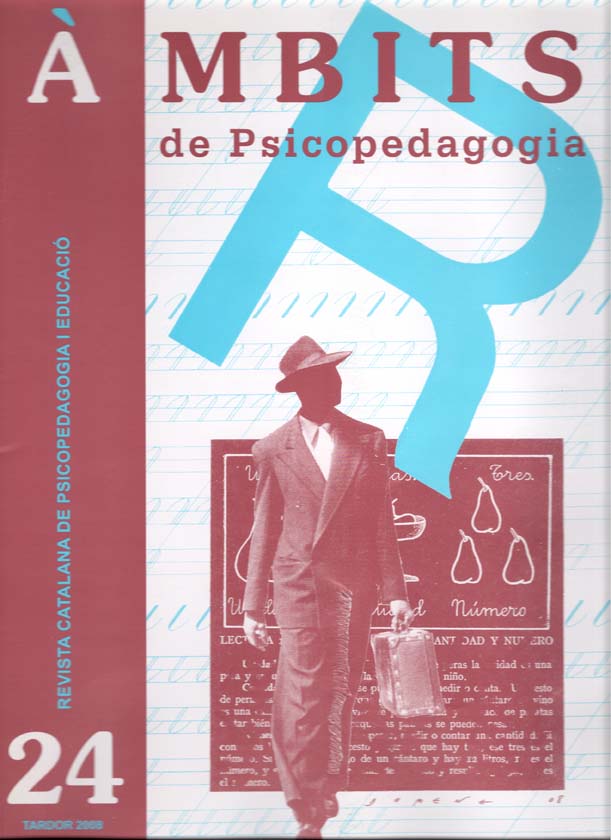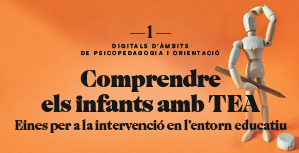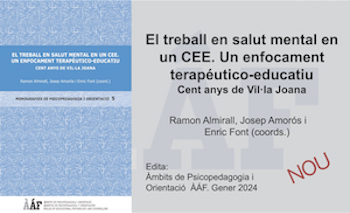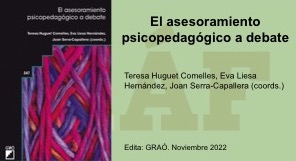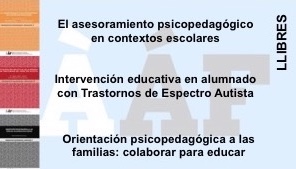Personal Style, Values and Alliance
Abstract
Currently there are many studies devoted to research on the significance of therapist's variables during the psychotherapy process and outcomes. After many years with a patient's psychopathological properties and the specific techniques of intervention as a principal variables researched, nowadays we know that the therapist is a one of the protagonists in the therapeutic process and, in recent years, several researchers have been studying it (Corbella, 2008; Hill, 2007). This paper raises some items of the psychotherapy research like Therapist's Personal Style and Therapeutic Alliance and their relationship between psycotherapy and psychopedagogy.
References
Atkinson, D., & Schein, S. (1986). Similarity in counseling. The Counseling Psychologist, 14, 319-354.
Bachelor, A. (1991). Comparison and relationship to outcome of diverse dimensions of the helping alliance as seen by client and therapist. Psychotherapy, 28, 534-549.
Barber, J. P., Connolly, M. B., Crits-Christoph, P., Gladis, L., & Siqueland, L. (2000). Alliance predicts patients' outcome beyond in-treatment change in symptoms. Journal of Consulting and Clinical Psychology, 68(6), 1027-1032.
Bergin, A. E. (1980). Psychotherapy and religious values. Journal of Consulting and Clinical Psychology, 48, 95-105.
Bergin, A. E., & Jansen, J. P. (1989). Religiosity of psychotherapists: A national survey. Psychotherapy, 27, 3-7.
Beutler, L. E., Arizmendi, T. G., Crago, M., Shandfield, S., & Hagaman, R. (1983). The effects of value similarity and clients’ persuadability on value convergence and psychotherapu improvement. Journal of Social and Clinical Psychology, 1, 231-245.
Beutler, L. E., & Bergan, J. (1991). Value change in counseling and psychotherapy: A search for scientific credibility. Journal of Counseling Psychology, 38, 16-24.
Beutler, L. E., Clarkin, J. F., & Bongar, B. (2000). Guidelines for the systematic treatment of the depressed patient. New York, NY, US: Oxford University Press.
Beutler, L. E., Clarkin, J., Crago, M., & Bergan, J. (1991). Client-therapist matching. En C. R. Snyder y D. R. Forsyth (Eds.), Handbook of social and clinical psychology: The heath perspective (pp. 699-716). Elmsford, NY: Pergamon.
Beutler, L. E., & Clarkin, J.F. (1990). Systematic treatment selection: toward targeted therapeutic interventions. New York: Brunner/Mazel.
Beutler, L. E., & Harwood, T. M. (2000). Prescriptive psychotherapy: A practical guide to systematic treatment selection. New York, NY, US: Oxford University Press.
Beutler, L. E., Machado, P. P., & Neufeldt, S. (1994). Therapist variables. En A. E. Bergin y S. L. Garfield (Eds.), Handbook of psychotherapy and behavior change (4ª ed., pp. 229-264). New york: John Wiley.
Bordin, E. S. (1976). The generalization of the psychoanalytic concept of the working alliance. Psychotherapy: Theory, Reseach and Practice, 16, 252-260.
Bordin, E. S. (1994). Theory and research on the therapeutic working alliance: New directions. En A. O. Horvath y L. S. Greenberg (Eds.). The working
alliance: Theory, research, and practice (pp. 13-37). New York: Wiley.
Botella, L. y Corbella, S. (2005). Neurobiología de la Autorregulación Afectiva, Patrones de Apego y Compatibilidad en la Relación Terapeuta-Paciente. Revista de Psicoterapia, 61, 77-104.
Corbella, S. (2003). Compatibilidad entre el Estilo Personal del Terapeuta y el Perfil Personal del Paciente. Tesis doctoral.
Corbella, S. y Botella, L. (2003). La alianza terapéutica: historia, investigación y evaluación. Anales de Psicología, 19, 205-221.
Corbella, S. y Botella, L. (2004a). Investigación en Psicoterapia: Proceso, Resultado y Factores Comunes. Madrid: Vision Net.
Corbella, S. & Botella, L. (2004b). Psychometric Properties of the Spanish Version of the Working Alliance Theory of Change Inventory (WATOCI). Psicothema, 16, 702-705.
Corbella, S., Fernandez-Alvarez, H. (2006). El terapeuta, posiciones, actitudes y estilos personales. En L. Botella (Ed.). Construcciones, narrativas y relaciones: Aportaciones constructivistas y construccionistas a la psicoterapia. Barcelona: Edebe.
Corbella, S (2008). Research on the Therapist’s Personal Style. Panel, Annual meeting, Society for Psychotherapy Research. Barceona, Espanya.
Fernández-Álvarez., & García (1998). Cuestionario del Estilo Personal del Terapeuta. Buenos Aires: Aiglé.
Fernández-Alvarez, H. (1998). El estilo personal del psicoterapeuta. En Oblitas Guadalupe, L. A. Quince enfoques terapéuticos contemporáneos. México: El Manual Moderno.
Frank, J. D. (1973). Persuasion and healing: A comparative study of psychotherapy (rev. Ed.). Baltimore: The Johns Hopkins University Press.
Gelso, C. J., & Carter, J. A. (1994). Components of the psychotherapy Relationship: Their interaction and unfolding during treatment. Journal of Counseling Psychology, 41, 296-306.
Hill, C. (2006). Introduction to special section on therapist effects. Psychotherapy Research, 16(2), 143-144.
Horvath, A. O., & Luborsky, L. (1993). The role of the therapeutic alliance in psychotherapy. Journal of Consulting and Clinical Psychology, 61(4), 561-573.
Horvath, A. O., & Symonds, B. D. (1991). Relation between alliance and outcome in psychotherapy: A meta-analysis. Journal of Counseling Psychology, 38, 139-149.
Kelly, T. A. (1990). The role of values in psychotherapy: Review and methodological critique. Clinical Psychology Review, 10, 171-186.
Kelly, T. A. y Strupp, H. H. (1992). Patient and therapist values in psychotherapy: Perceived changes, conversion, similarity, and outcome. Journal of Consulting and Clinical Psychology, 60, 34-40.
Khan, J. A., & Cross, D. G. (1983). Mental health professional and client values: Similar or different? Australian Journal of Sex, Marriage y Family, 4, 71-78.
Luborsky, L. (1994). Therapeutic alliances as predictors of psychotherapy outcomes: Factors explaining the predictive sucess. En A. O. Horvath y L. S. Greenberg (Eds.), The working alliance: Theory, research, and practice (pp. 38-50). New York: Wiley.
Luborsky, L. (2000). A pattern-setting therapeutic alliance study revisited. Psychotherapy research, 1, 17-29.
Martin, D. J. (1999). Relation of the therapeutic alliance with outcome and other variables: A meta-analytic review., Ohio U, US.
Norcross, J. (2002). Psychotherapy Relationships that Work. Oxford: Oxford University Press.
Orlinky, D., Grawe, K., & Parks, B. (1994). Process and outcome in psychotherapy-Noch ein mal. En A. Bergin y J. S. Garfield, (Eds.). Handbook of psychotherapy and behavior change (4th Edition) (pp. 270-378). New York: Wiley and Sons.
Premack, D. y Woodruff, G. (1978). Does the chimpanzee have a theory of Mind? Behavioral and Brain Sciences, 1, 515-526.
Sturm, L., & Dawson, P. (1999). Working with families: An overview for providers, Kessler, Daniel B. (Ed); Dawson, Peter (Ed). (1999). Failure to thrive and pediatric undernutrition: A transdisciplinary approach. (pp. 65-76). Baltimore, MD, US: Paul H. Brookes Publishing Co.
Shafraske, E. P., & Malony, H. N. (1990). Clinical psychologists’ religious and spiritual orientations and their practice of psychotherapy. Psychotherapy, 27, 72-78.
Weerasekera, P., Linder, B., Greenberg, L., & Watson, J. (2001). The working alliance in client-centered and process-experiential therapy of depression. Psychotherapy Research, 11(2), 221-233.
Worthington, E. L., Jr. (1988). Understanding the values of religious clients: A model and its application to counseling. Journal of Counseling Psychology, 35, 166-174.
Downloads
Published
Issue
Section
License
The authors maintain their copyright and give the right to the first publication of the work to the journal, registered under a Creative Commons Attribution-Non Commercial-NoDerivs license. This license allows others to download the works and to share them with others as long as they credit the author, but it does not allow for any kind of modification or commercial use.


